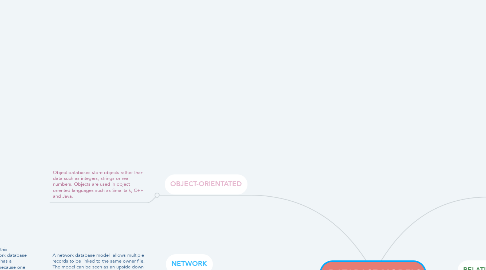
1. NETWORK
1.1. A network database model allows multiple records to be linked to the same owner file. The model can be seen as an upside down tree.
1.1.1. The multiple linkages which this information allows the network database model to be very flexible. It has a many-to-many relationship because one owner file can be linked to many member files and vice versa.
2. OBJECT-ORIENTATED
2.1. Object databases store objects rather than data such as integers, strings or real numbers. Objects are used in object oriented languages such as Smalltalk, C++ and Java.
3. STAR
3.1. Star schemas are denormalized. It splits up business process data into facts, which hold the measurable, quantitative data about a business, and dimensions which are descriptive attributes related to fact data.
3.1.1. Mainly used to develop data warehouses and dimensional data marts.
3.1.1.1. It is the simplest form of a dimensional model. The diagram is shaped like a star.
4. FLAT FILE
4.1. A flat file database stores data in a plain text file. Each line of the text file holds one record, with fields separated by delimiters.
4.1.1. It uses a simple structure and cannot contain multiple tables like a relational database can. It is used by many applications to store data related to configuration.
5. RELATIONAL
5.1. Relational databases store data in tables that are two dimensional. The tables have rows and columns. These tables are normalized.
5.1.1. It uses SQL. New data can be added without requiring that all existing applications be modified.
5.1.1.1. One-to-one, one-to-many and many-to-many relationships are used. Many organisations use this.
6. HIERARCHICAL
6.1. Uses a one-to-many relationship and a tree structure unlike to a network database.
6.1.1. This model is not very flexible like a network database model and has very few uses. It is now outdated but some IBM and Microsoft Models still exist.

